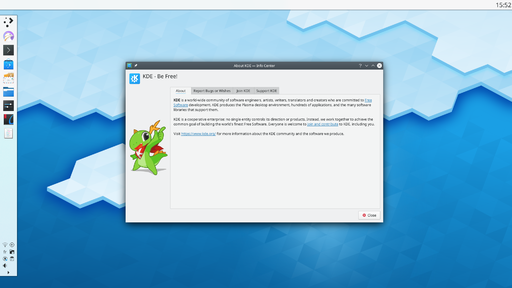Plasma/Panels/fr: Difference between revisions
ChristianW (talk | contribs) (Created page with "*<menuchoice>Supprimer ce panneau</menuchoice>: supprime le panneau courant avec tous ses widgets.") |
ChristianW (talk | contribs) (Created page with "Category:Desktop/fr Category:Plasma/fr") |
||
| Line 71: | Line 71: | ||
Locking can be done by either selecting the <menuchoice>Lock Widgets</menuchoice> entry in the Panel toolbox's <menuchoice>More Settings</menuchoice> menu or in the Panel context (right click) menu. Once locked, the Panels can be unlocked again by right clicking on either a panel or desktop and selecting <menuchoice>Unlock Widgets</menuchoice> from the menu that is displayed. | Locking can be done by either selecting the <menuchoice>Lock Widgets</menuchoice> entry in the Panel toolbox's <menuchoice>More Settings</menuchoice> menu or in the Panel context (right click) menu. Once locked, the Panels can be unlocked again by right clicking on either a panel or desktop and selecting <menuchoice>Unlock Widgets</menuchoice> from the menu that is displayed. | ||
[[Category:Desktop]] | [[Category:Desktop/fr]] | ||
[[Category:Plasma]] | [[Category:Plasma/fr]] | ||
Revision as of 11:37, 19 February 2018
Panneaux du bureau Plasma

Un panneau est un conteneur d'application (widget) qui peut se trouver sur le bureau, de n'importe quel côté. On peut trouver plusieurs panneaux d'un même côté. Par défaut l'affichage est de un panneau qui s'étire en bas sur toute la largeur du bureau avec les widgets suivants à l'intérieur : menu application , desktop pager, gestionnaire des tâches (liste des fenêtres ouvertes), barre d'état (avec dedans, des éléments comme un détecteur d'appareils) et une horloge. Si vous utilisez un ordinateur portable, un netbook ou tout autre ordinateur utilisant une batterie il y aura aussi un widget de gestion d'alimentation dans la barre d'état. Au bout du panneau il y a une boîte à outils qui peut être activée pour accéder aux options de configuration.
Configuration
Le panneau peut ensuite être configuré en cliquant sur la boîte à outils située sur la droite pour un panneau horizontal, ou en bas pour un panneau vertical. A cette étape, le panneau est en mode configuration. Vous pouvez accéder à la configuration du panneau par l'intermédiaire de son menu contexte (clic droit).

Les widgets du panneau peuvent être triés en les faisant glisser quand vous êtes en mode configuration. Les widgets s'alignent à partir de la gauche dans le panneau horizontal et à partir du haut dans le panneau vertical
Boîte à outils des panneaux
- : vous permet de déplacer le panneau vers l'un des quatre bords d'écran.
- (pour le panneau horizontal): permet d'ajuster la hauteur du panneau.
- (pour le panneau vertical): permet d'ajuster la largeur.
- : permet d'ajouter des widgets au panneau.
- : Allows you to add a spacer into the panel giving space between the items in it.
- The standard behavior of a spacer is that it uses as much space as possible (flexible size), but you can also set it to a . Enter the context (right click) menu and deactivate .
Menu "Plus d'options"
- : Allows the alignment of the panel to be set in three pre-set positions.
-
- : Keeps the panel visible at all times, even when windows are maximised.
- : Hides the panel off screen until the mouse is placed near the screen edge.
- : This allows windows to cover the panel and if maximised, will cover the panel.
- : This allows windows to go below the panel, even when maximised.
- : aligne le panneau sur les bords de l'écran, s'il a été redimensionné.
- : bloque le panneau et les widgets à leur position. Cache également la boîte à outils.
- : supprime le panneau courant avec tous ses widgets.
Sous le manteau
Should anything "untoward" happen to your panel have a look at ~/.kde(4)/share/config/plasma-desktop-appletsrc - the panel itself is classed as a containment (there are at least two, the desktop and the panel) which is home to all the different widgets you put there.
Panneaux multiples
It is also possible to have more than one panel on your desktop. This proves useful if you want to have a more flexible layout:

Ajouter un panneau
To add a new panel either click on the desktop toolbox button and select or open the context (right click) menu on the desktop and select from the menu.
If more than one kind of Panel is installed, you will be able to select between them to choose what sort of Panel you would prefer. By default, two Panel types are available: , which creates a Panel containing all of the default widgets (launcher, pager, tasks, system tray, clock, etc.), and , which adds an empty Panel without any pre-configured widgets in it.
Verrouillage
Les panneaux et le bureau peuvent être vérrouillés pour empêcher de les modifier. Quand sont verrouillés, les boutons de la boîte à outils n'apparaissent pas, ni sur le bureau, ni sur les panneaux. Pour configurer un panneau, il doit être déverrouillé, sinon la boîte à outils et les entrées du menu contextuel à configurer ou l'ajout de widgets ne sont pas accessibles.
Locking can be done by either selecting the entry in the Panel toolbox's menu or in the Panel context (right click) menu. Once locked, the Panels can be unlocked again by right clicking on either a panel or desktop and selecting from the menu that is displayed.

